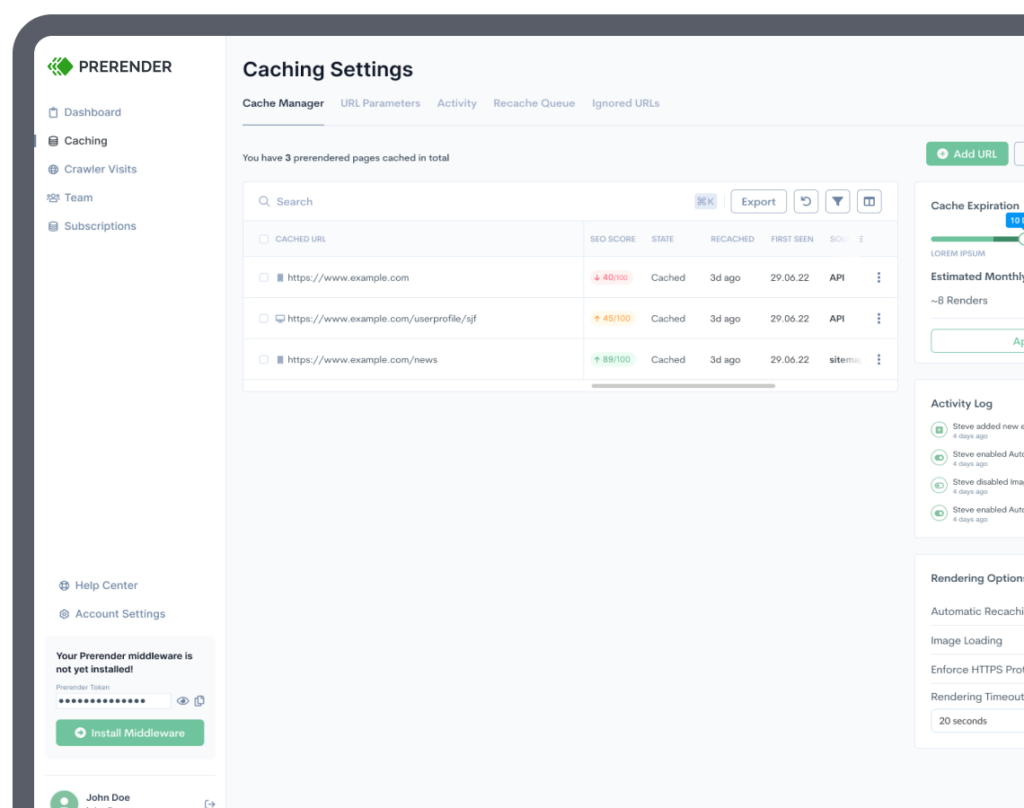Looking for the best GEO tools to boost your site’s visibility in generative AI search engines like ChatGPT, Gemini, or Perplexity?
Generative Engine Optimization (GEO) or AEO (Answer Engine Optimization) is part of the evolution of SEO. Ensuring your website meets the GEO criteria increases your content’s chance to appear in AI-generated answers instead of just Google rankings.
In this guide, we’ll break down the best technical GEO and LLM optimization tools for 2026, how they compare, and what makes them essential for ranking in the world of generative search.
What is Generative Engine Optimization (GEO) And How Does It Work?
The key to understanding GEO lies in its “generative” part. Unlike traditional SEO (Search Engine Optimization), which ” searches” the internet to give you a list of content relevant to your keyword-based search, GEO “generates” the answer. It processes information from several sources and presents it with one answer.
For example, if someone asks, “How do I get my website featured on AI search engines?” GEO-optimized content with clear, well-structured, and authoritative information could be the one ChatGPT, Perplexity, or Gemini cites (or one of the citations). This means that to get recommended in GEO search results, your need to ensure that your content is easily accessible and interpreted by GEO and LLM-based searches.
Some LLMs, like Perplexity and Gemini, use real-time web retrieval to surface and cite live content. Others, like ChatGPT, combine pre-trained knowledge with live browsing capabilities to pull in fresh data when relevant. GEO ensures your content is accessible, renderable, and trustworthy, whether AI models encounter it during training or through live citation retrieval.
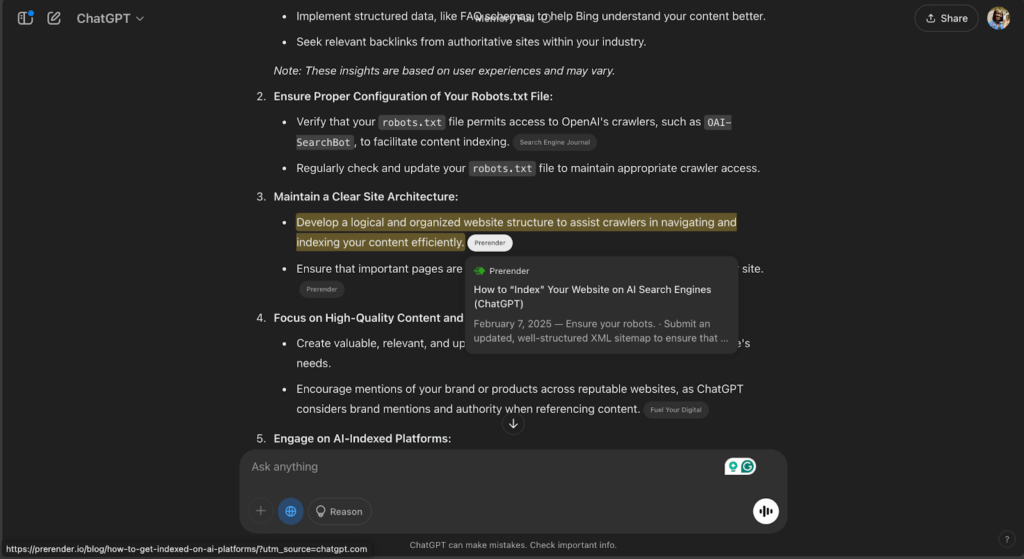
How Can You Use GEO Tools to Improve AI Search Rankings?
GEO tools help brands identify how LLMs interpret your site, track citations across AI platforms, and reveal where content is missing from AI-generated results.
SEO vs. GEO: How is GEO Different From Traditional SEO?
Both SEO and GEO aim to help users find relevant, trustworthy information, but they do so in very different ways. While SEO focuses on ranking content in traditional search engines, GEO makes content discoverable and interpretable by AI systems.
In many ways, GEO builds on the foundations of SEO rather than replacing it: it’s an evolution, not a departure. Let’s explore how traditional search engines and generative AI platforms differ in how they understand and deliver content.
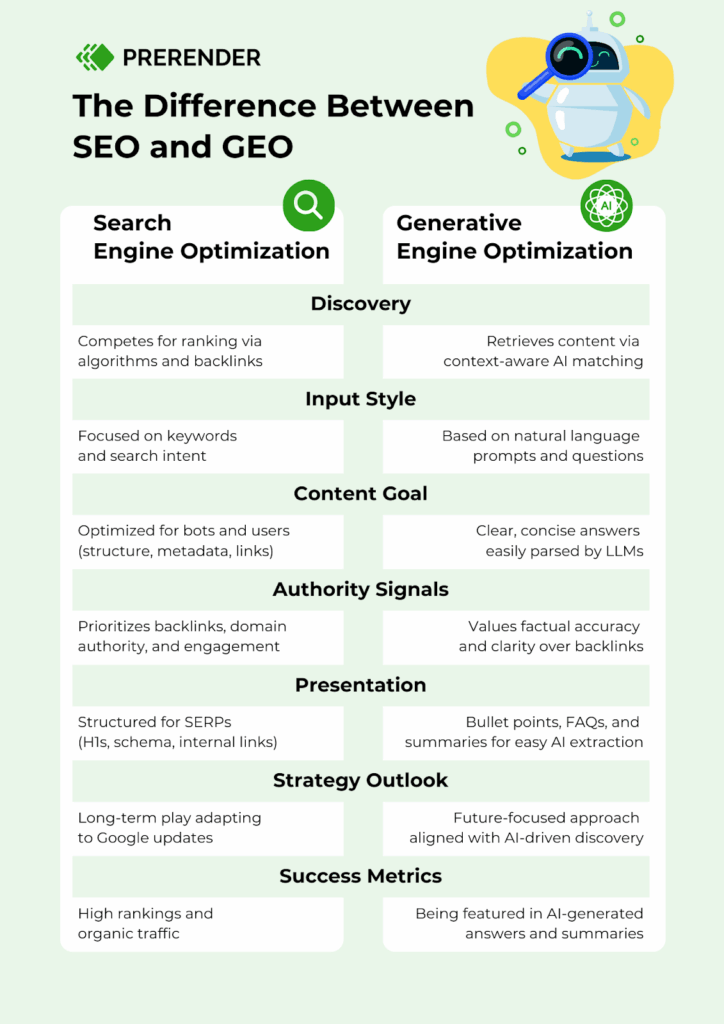
Read: Traditional Search vs. AI-Powered Search Explained
The Ranking vs. Retrieval Process
In SEO, websites compete for rankings based on algorithms that evaluate relevance, authority, content quality, and user engagement: Google’s bots crawl, index, and rank pages according to these factors.
In contrast, LLMs and generative AI search engines retrieve and present content that best matches the query context, often with no fixed “ranking” but based on how well the content answers the question.
Search Queries vs. AI Prompts
Keywords and search intent are at the core of SEO. Marketers conduct keyword research to understand users’ needs and optimize content around those terms. Matching their intent (whether informational, transactional, or navigational) is key to ranking higher.
Instead of targeting matching keywords, AI platforms rely on natural language processing (NLP) and prompts to understand users’ queries and provide relevant, conversational responses.
Authority and Credibility
Search engines like Google prioritize authoritative sites with strong backlink profiles. So, sites with well-cited sources, expert authorship, and high engagement tend to perform better.
In contrast, GEO prioritizes factual accuracy and clarity over backlinks so that large language models (LLMs) like ChatGPT and Perplexity can confidently retrieve and present it.
Related: How Do LLMs Decide What Content to Recommend?
Content Format and Presentation
In SEO, content needs to be optimized for users and search engines. This includes using proper heading structures, internal linking, image alt text, and structured data markup to enhance search visibility.
In GEO, the focus is on clear, concise, and structured content that directly answers questions. Bullet points, FAQ sections, and summaries work well here because AI can extract and present them quickly.
Long-Term Strategy and Future-Proofing
SEO is a long-term game that evolves with search behavior and Google’s algorithm updates. So, websites must continuously adapt by improving technical SEO, updating content, and following SEO best practices to maintain rankings.
AI-powered search is gaining more ground, so businesses must align and future-proof their strategy with GEO. However, properly structuring content for machine comprehension rather than just human readability is the challenge.
Download for your next read: Get Found Beyond Google: Free AI Visibility Playbook. Learn how AI crawlers like ChatGPT, Gemini, and Perplexity process content differently from Google and the technical steps to make your site visible in AI search.
The Best GEO Tools to Optimize Your AI SEO Performance
The following technical GEO AI optimization tools will ensure that generative models can find, understand, and retrieve your content when users ask related questions.
1. Prerender.io for GEO Web Optimization
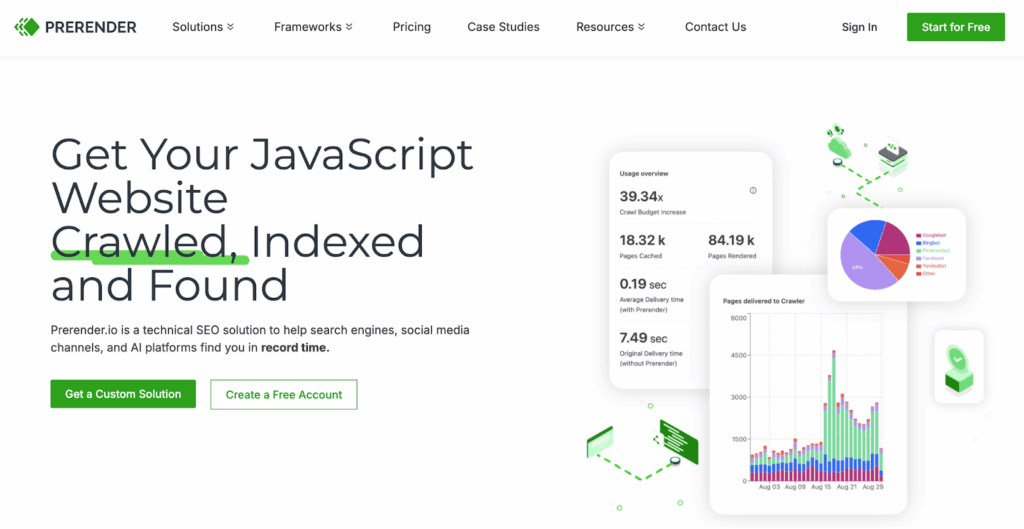
Like traditional search crawlers, AI crawlers often struggle to execute JavaScript, which can prevent them from processing and rendering JS-based content. However, Prerender.io solves this by generating fully rendered HTML versions of your pages, ensuring better visibility for AI crawlers and traditional search engines.
Key Features of Prerender.io for SEO and GEO Optimization:
- Pre-renders dynamic web pages for better GEO/AIO and SEO visibility.
- Headless browsing-based pre-rendering to fix indexing delays.
- Optimized caching system for improved Core Web Vitals.
- Seamless integration with major JavaScript frameworks, such as ReactJS, AngularJS, and VueJS.
- Customizable caching rules for enhanced site performance.
- Flexible and scalable API solution for easy custom workflow integration.
- Features a keyword rank tracker, SEO scoring, and an ROI calculator.
Prerender.io is best for:
- Websites built with JavaScript-heavy frameworks (React, Angular, Vue).
- Enterprise-size websites and ecommerce sites struggling with AI crawlers not indexing their dynamic content properly and quickly, causing incorrect information on Google SERPs or invisible content to AI crawlers.
GEO challenges solved by Prerender.io:
- Ensures AI search engines (ChatGPT, Gemini, Perplexity) can read and render JS content.
- Improves crawlability, renderability, and citation potential.
- Reduces indexing delays and improves Core Web Vitals.
Why does Prerender.io stand out from other GEO tools?
Unlike other GEO AI tools, Prerender.io optimizes your JS rendering so AI crawlers can find and feature you. Our plug-and-play setup works across multiple frameworks, making integration seamless.
Also, by pre-rendering pages server-side, Prerender.io enhances SEO performance—a crucial factor in generative engine optimization—leading to increased organic traffic and revenue. In fact, one of our customers sees a significant impact on their traffic after adopting Prereder.io and adding the ChatGPT user agent to their account, resulting in around a 300% increase in referral traffic from the ChatGPT AI search results.
And because every site has different goals, the AI Dashboard now features customizable KPI cards, letting you focus on the performance metrics that matter most to your business. You can monitor:
- Pages crawled – see how many pages are visited and spot trends over time.
- Cache hit ratio – measure how efficiently your site is being served from cache for faster performance.
- Error rate – catch potential indexing or rendering issues before they impact search visibility.
- Average crawl time – compare performance with and without Prerender.io to prove real gains.
By combining these insights with Prerender.io’s rendering and caching technology, you’re equipped with both the tools and the data to optimize for today’s search engines and tomorrow’s AI-driven discovery.

Resource: See Why AI Crawlers Struggle to Render JavaScript
| Do AI-based search engines have crawlers? When we refer to AI crawlers, we mean the systems or APIs used by AI models (like Bing-powered integrations) to access or retrieve live data—not traditional bots like Googlebot. |
2. Keyword.com
Keyword.com has been one of the strongest keyword rank tracking in the market, and recently, they have just expand their tools to track ranks on AI searches.
Just like traditional SEO, knowing where your site stands against your competitors is key to winning the game. In the GEO landscape, this means understanding which content gets cited on ChatGPT, Gemini, and Claude, how it is presented on the AI results, and how much AI referral traffic you have received over the past days.
Key Features of Keyword.com:
- Track your brand mentions across ChatGPT, Google AI Overviews, and other LLM search engines.
- See what AI search engines say about you to ensure your content leads the conversation.
- Observe how your content moves over time to identify strategic opportunities.
- Uncover the content that AI platforms feed from to answer questions about your brand.
Keyword.com is best for:
- Brands wanting to track AI search visibility and citation presence.
- SEO teams looking to understand AI search performance compared to competitors.
Challenges solved by Keyword.com:
- Monitors brand mentions, citations, and AI referral traffic.
- Reveals which AI platforms cite your content and which prompts trigger mentions.
- Helps measure visibility and sentiment across AI search engines.
Why does Keyword.com AI Rank Tracker stand out?
Keyword.com’s AI overview tracker distinguishes itself by offering comprehensive data on your competitors and your own site’s performance in AI searches.
For example, you can specify a search query and receive GEO-targeted results, revealing which brands are mentioned. The tool then provides insights into the sentiment surrounding these brands and identifies the specific content that led to their inclusion in the AI’s response. Other GEO metrics you can track include visibility score, mentions, citations, and top 3 visibility. This competitive insight is crucial for evaluating the effectiveness of your AI optimization strategies.
3. PeecAI

Peec AI offers a compelling alternative for GEO brand monitoring, empowering users to effectively analyze, track, and enhance their AI rankings across major GEO-based search engines.
Key features of Peec AI:
- Track recent mentions of your brand in various prompts.
- See how much AI market share you own compared to your competitors.
- Get instant alerts when your brand visibility changes to leverage opportunities.
PeecAI is best for:
- Companies needing prompt-level insights into AI citations.
- Brands that require real-time monitoring of AI visibility and market share.
Challenges solved by PeecAI:
- Tracks specific prompts that lead to content being generated or cited.
- Provides performance metrics like visibility rate and source attribution.
- Sends alerts for visibility changes, enabling timely content adjustments.
Why does Peec AI stand out?
Peec AI stands out by focusing on prompt-level optimization for GEO search. It goes beyond simply tracking if generative AI cites your content. Instead, Peec AI analyzes which specific prompts lead to your content being generated. It then measures crucial performance metrics like visibility rate and source attribution, giving you a detailed understanding of what’s working and how to refine your content for optimal performance across various AI models.
Listen to our Get Discovered podcast, featuring Marius Meiners, the founder of PeecAI. In it, we discuss how brands can measure real-time visibility and stay ahead in AI search.
4. Writesonic
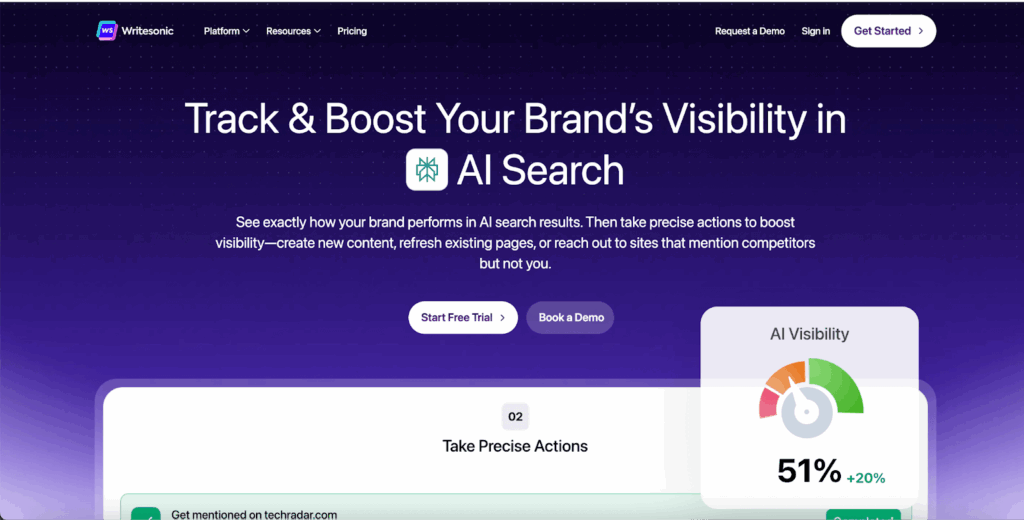
Writesonic combines AI search visibility tracking with a complete SEO and content engine.
Instead of just showing where your brand appears in AI search results, Writesonic gives you the tools to act: closing citation gaps, optimizing content, and improving technical SEO in one place
Key Features of Writesonic:
- Track mentions, citations, sentiment, and share of voice across AI platforms.
- See real prompts users ask AI (not just keywords) and predict search volume.
- AI Visibility Action Center with recommendations for missing citations, content refreshes, and technical fixes.
- Built-in SEO tools for keyword research, clustering, and AI-powered content creation.
- Technical GEO fixes for schema, crawlability, and broken URLs.
- Competitor gap analysis to find sites citing others but not you.
Writesonic is best for:
- Teams seeking both AI visibility tracking and actionable content optimization.
- Marketing teams that want recommendations alongside insights.
Challenges solved by Writesonic:
- Identifies missing citations and content gaps for AI search engines.
- Provides AI-powered content creation and optimization for GEO.
- Suggests technical fixes, including schema, crawlability, and broken URLs.
Why does Writesonic stand out?
Unlike monitoring-only tools, Writesonic combines visibility insights with action. It helps you rank on Google and get cited by AI, making it a complete GEO solution trusted by 20,000+ teams.
5. HubSpot’s AI Search Grader

Hubspot’s AI Search Grader is a powerful free tool that analyzes your site’s visibility in AI search tools. It reveals how AI models view and perceive your products or services, and highlights areas for improvement.
Key Features of Hubspot’s AI Search Grader:
- Assesses and provides quick snapshots of brand performance across AI search engines.
- Analyzes AI-generated responses to gauge brand perception.
- Compares brand visibility with competitors in key search queries.
- Identifies success areas and opportunities for improvement.
HubSpot AI Search Grader is best for:
- Businesses looking for quick, easy AI visibility benchmarking.
- Teams without deep technical or AI expertise seeking actionable insights.
Challenges solved by HubSpot AI Search Grader:
- Analyzes brand perception and visibility across AI search engines.
- Highlights areas for improvement in AI-generated answers.
- Compares brand performance with competitors on key queries and prompts.
Why does Hubspot’s AI Search Grader stand out?
HubSpot’s AI Grader simplifies content optimization for AI-driven search. It automates prompt creation, provides actionable insights, and requires no prior, extensive AI expertise. Plus, it’s free and available worldwide.
6. Ahrefs AI Content Helper
Ahrefs AI Content Helper offers advanced search intent analysis and competitive benchmarking for top-performing content.
Key Features of Ahrefs Content Search Helper:
- All-in-one solution for keyword research, content drafting, optimization, and performance tracking.
- Analyzes top-ranking pages to reveal Google’s content preferences for target keywords.
- Helps align content with user intent for better search visibility.
- Uses AI to identify core topics related to target keywords.
- Offers competitor insights, including full HTML access, to refine content structure and formatting.
- Ensures comprehensive topic/content coverage for stronger SEO results.
Ahrefs AI Content Helper is best for:
- Content teams focused on high-quality, topic-focused content.
- Websites aiming to align content with user intent for AI relevance.
Challenges solved by Ahrefs AI Content Helper:
- Provides search intent analysis and competitive benchmarking.
- Guides on structuring content for better retrieval by LLMs.
- Ensures comprehensive topic coverage for stronger AI and SEO performance.
Why does AI Content Helper stand out?
Unlike tools emphasizing keyword density, AI Content Helper prioritizes topic optimization—delivering thorough, high-quality content without keyword stuffing or score manipulation.
7. Frase
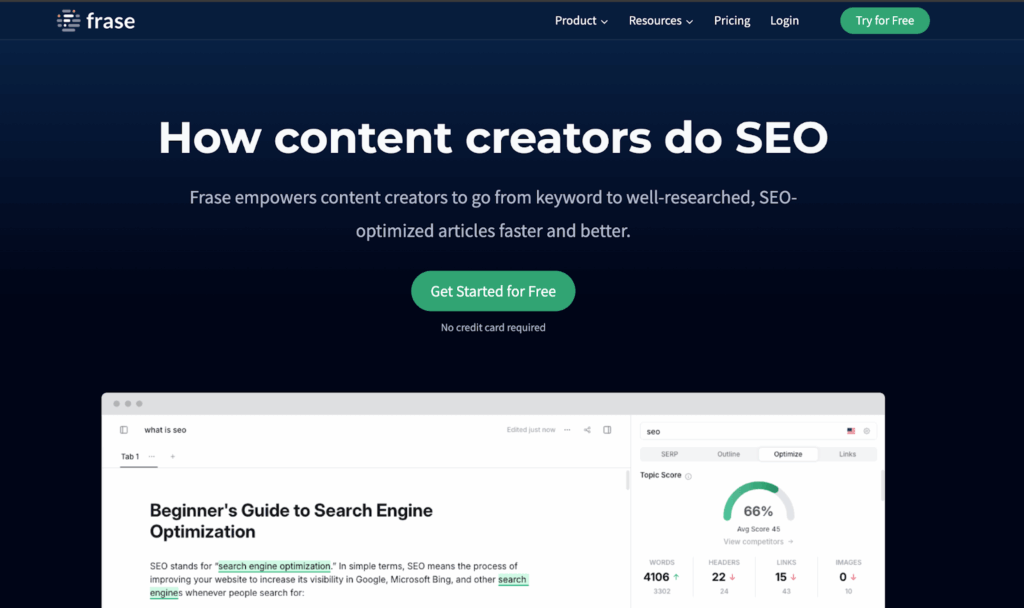
Frase is an AI-powered content optimization tool that combines research, writing, and SEO in an intuitive editor. Its AI writer and editor help you create high-quality, search-friendly articles while optimizing keywords and answering common questions—key factors for good placements in generative search results.
Key Features of Frase:
- End-to-end SEO workflow from research to optimization.
- Automated content audits and prioritization using SERP and competitor analysis data.
- AI-powered comprehensive content editor for seamless writing and optimization.
- Customizable tools for efficiency like Outline Builder and Automatic Content Briefs.
- Supports multiple languages for global accessibility.
Frase is best for:
- Writers and content teams seeking end-to-end AI SEO guidance.
- Companies producing high volumes of AI-targeted content.
Challenges solved by Frase:
- Combines research, content creation, and optimization in one workflow.
- Structures articles for AI retrieval with headings, summaries, and FAQ sections.
- Automates AI-search-friendly content generation for better indexing.
Why does Frase stand out?
Frase blends writing and SEO, allowing real-time optimization as you create. Its AI Article Agent automates AI-search-friendly content, while proprietary topic modeling enhances search relevance and rankings.
8. Surfer
Surfer is a cloud-based tool that combines AI-based insights with SEO practices to streamline research, content creation, and optimization. It provides structured guidelines on keywords, content length, and SEO factors to improve visibility across both search engines and AI systems.
Key Features of Surfer:
- Provides real-time SEO suggestions for content structure, keyword density, and optimization.
- Analyzes SERPs to deliver detailed keyword insights.
- Evaluates existing content and provides actionable suggestions for improvement.
- Features both the AI Detector and AI Humanizer tools.
- Supports keyword research for content creation (though less extensive than Ahrefs).
- Integrates with platforms like WordPress and Google Docs.
Surfer is best for:
- Businesses needing data-driven content optimization for AI and SEO.
- Teams using SERP analysis to refine content relevance.
Challenges solved by Surfer:
- Provides real-time recommendations on content structure, keyword density, and optimization.
- Evaluates existing content and offers actionable improvements.
- Enhances both SEO and AI visibility by aligning content with search intent.
Why does Surfer stand out?
Surfer stands out for its comprehensive content optimization, seamless UX, and advanced SERP analysis, helping to refine your GEO strategy effectively.
Top Technical GEO Tools for Generative AI Search Visibility in 2026
Quick reference for choosing the right GEO tools to improve AI indexing, prompt-level visibility, and content discoverability across ChatGPT, Gemini, Perplexity, and other AI search platforms.
| Tool | Best For | Challenges Solved |
| Prerender.io | JavaScript-heavy websites | Makes dynamic content visible to AI crawlers, speeds up indexing, and increases AI citations chance |
| Keyword.com | Brands tracking AI mentions | Monitors citations, prompts, visibility, and AI referral traffic |
| PeecAI | Prompt-level visibility | Tracks which prompts trigger content, provides real-time alerts and metrics |
| Writesonic | Teams needing content/on-page SEO insights | Finds content gaps, suggests optimizations, improves technical GEO issues |
| HubSpot AI Search Grader | Quick AI visibility benchmarking | Measures brand perception, compares performance, highlights improvement areas |
| Ahrefs AI Content Helper | Content teams | Aligns content with user intent, ensures topic coverage, improves AI and SEO relevance |
| Frase | Writers and high-volume content teams | Structures AI-friendly content, automates creation, optimizes for indexing |
| Surfer | Data-driven content optimization | Provides real-time content improvements, enhances AI and SEO visibility |
How to Position Your Website for GEO and AI Search Success (GEO Best Practices)
GEO is still a foreign concept to many businesses, meaning there’s a golden opportunity to get ahead before the competition catches on. Now that you know how GEO differs from traditional SEO and the top GEO tools that can help you improve your overall GEO citation, here are some tips to get your website to show up on AI search engine results:
1. Create High-Quality, Relevant Content
Generative search tools prioritize content that is comprehensive, informative, and directly aligned with user intent. To optimize for AI search algorithms:
- Write well-researched content that fully answers user queries.
- Avoid fluff and focus on delivering value in a clear, concise manner.
- Use natural, conversational language that mirrors how people search.
- Incorporate first-hand expertise, case studies, real-world examples, and unique insights.
Related: Discover How to Make Your AI-Generated Content Indexed Faster
2. Build Depth With Topical Authority
The more depth and expertise you show, the more likely AI search engines will surface your content when users ask questions in your niche.
- Create content clusters around core subjects relevant to your industry.
- Help AI crawlers (and readers) navigate your content by linking related articles.
- Update your old content with new stats, trends, or insights to maintain freshness.
- Engage in industry conversations through authoritative publications.
3. Focus on User Experience
Like traditional search engines, generative search tools prioritize websites, offering a seamless user experience. Improve your engagement and accessibility by:
- Pre-rendering your JS-heavy site with Prerender.io for fast-loading pages.
- Enhancing site navigation for easy content discovery.
- Prioritizing mobile-friendliness. Ensure your site adjusts to any screen size for a smooth mobile experience.
- Reducing intrusive ads, pop-ups, and disruptive elements.
- Encouraging user interactions through well-placed CTAs.
4. Structure Your Content for AI
AI models need clear structures to understand and generate responses effectively. Here’s how to structure articles for better GEO ranking:
- Use clear headings, subheadings, and short paragraphs.
- Format content with bullet points, tables, and numbered lists where relevant.
- Implement schema markup (FAQ, how-to guide, etc.) to help AI categorize information.
- Provide direct answers at the start of sections to increase the chances of being cited in AI-generated summaries.
5. Maintain Consistent Brand Information
Since AI search engines pull data from multiple sources, your brand’s consistency is crucial. Here’s how to ensure that:
- Standardize your business details everywhere. Your name, address, phone number, and branding elements (like your logo) should be uniform across all platforms.
- Monitor and update your social media profiles, directories, and knowledge panels.
- Encourage reputable mentions from trusted sources, even without backlinks.
- Maintain a strong industry listing presence, if applicable. For example, an up-to-date presence on G2 can boost your credibility in AI search if you’re a software company.
6. Leverage Technical SEO Practices
Technical SEO remains a cornerstone of both traditional and AI search optimization. A technically sound site ensures AI can access, understand, and retrieve your content effectively. Some of the best practices include:
- Ensuring proper indexing and crawlability through robots.txt and XML sitemaps. Use technical SEO tools like Google Search Console to spot and fix crawlability issues.
- Implementing canonical tags to prevent duplicate content issues.
- Optimizing internal linking structures to strengthen your topical relevance.
- Using hreflang tags for multilingual content targeting (to ensure AI shows the right version to the right users).
Optimize Your Website for Generative AI Search Engines With Prerender.io
Generative Engine Optimization (GEO) is part of search visibility, and it’s shaping how users discover brands online. You need the right AI search optimization tools and a solid technical foundation to stay competitive.
Even the most advanced GEO tools can’t help if your content isn’t being rendered properly. That’s where Prerender.io comes in. Our dynamic rendering solution ensures that your JavaScript-heavy pages are fully visible to both search engine bots and AI crawlers like ChatGPT, Gemini, and Perplexity, improving crawlability, readability, and citation potential.
When you install Prerender.io and configure AI user agents, you’ll see measurable improvements in AI referral traffic, crawl efficiency, and GEO visibility.
Start optimizing with Prerender.io today to make your content discoverable in AI search.
Frequently Asked Questions About GEO and AI Search Optimization Tools
1. What Are the Best GEO Optimization Tools for 2026?
Some of the best GEO (Generative Engine Optimization) tools for 2026 include:
- Prerender.io: for dynamic rendering and AI crawler visibility.
- Keyword.com: for tracking citations and brand mentions across ChatGPT, Gemini, and Claude.
- PeecAI: for real-time brand monitoring and prompt-level GEO analysis.
- Frase and Surfer: for structuring and optimizing content for AI-driven search.
- HubSpot’s AI Search Grader: for quick visibility benchmarking.
Each tool plays a different role in your GEO stack, from technical rendering to content optimization and performance tracking.
2. How Do I Compare AI Search Optimization Tools?
When comparing AI search optimization tools, look for:
- Technical GEO features: does it improve crawlability, rendering, or structured data?
- Visibility tracking: can it measure brand mentions or citations in ChatGPT or Perplexity?
- Actionability: does it only report insights, or can it help you fix issues directly?
- Integration flexibility: can it connect to your analytics or CMS?
3. Which GEO Tools Track How LLMs Interpret My Site?
Platforms like Keyword.com and PeecAI offer insight into how LLMs interpret your site. They show which of your pages are cited, what queries trigger mentions, and how your brand appears in AI responses. To make this data reliable, ensure your content is renderable and machine-readable with Prerender.io so AI crawlers can actually access the context behind your pages.
4. How Reliable Are Real-Time Brand Monitoring Features in GEO Platforms?
Real-time GEO monitoring tools like PeecAI are increasingly accurate, as they connect directly to AI models’ APIs or use search integrations (e.g., Bing-powered retrieval). However, accuracy depends on how accessible your content is to these crawlers. Using Prerender.io improves reliability by ensuring AI platforms can read your pages fully, making your visibility metrics more consistent.
5. How Can I Track My Website’s Performance in AI Search Engines?
Use AI rank-tracking tools such as Keyword.com or HubSpot’s AI Search Grader to monitor citations, visibility, and AI referral traffic. Pair them with Prerender.io’s Free Site Audit to ensure your technical setup supports AI crawlers. Tracking both your technical readiness and brand presence gives you the clearest view of your GEO performance.



